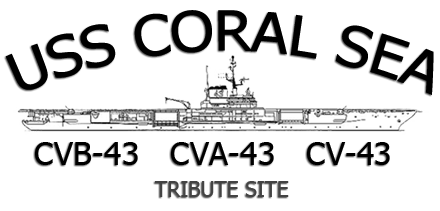
AGELESS WARRIOR
• THE NATURAL
• SAN FRANCISCO'S OWN
• BEST IN THE WEST
• CORAL MARU



FIRST NUCLEAR WEAPON LAUNCH FROM AN AIRCRAFT CARRIER: APRIL 21, 1950
Reflections On NSWU #471 Operations
LCDR Roy A. Norman, USN (ret)
I was an Electronics Technician First Class at the time and went aboard USS Coral Sea with the two parties involved in the first launch. I was responsible for the nuclear components we took, along with the required test equipment and tools. The section in the history "Keepers of the Dragon", (a History of the Nuclear Weapons Program; Henry B. Smith, Lt. Cmdr., USN (ret) ), about storage of the nuclear weapon components is correct as I read it.
The USS CORAL SEA (CVB-43) was in the Portsmouth Naval Shipyard for, among other things, completion of the Special Weapons spaces. On 15 March, 1950 some members of NSWU #471 took training weapons, tools, and test equipment and flew to East Island Naval Air Station, Norfolk. We left Albuquerque at 0430 and arrived at the air station at 1430 and were on board ship by 1600. We spent the next day cleaning the spaces, then holding assembly drills.
Underway from the shipyard at 0730 on the morning of the 17th, we spent that day and part of the 18th holding more drills and getting acquainted with the ship. The ship anchored in Hampton Roads on the evening of 18 March and moved to pier 5 Naval Operations Base, Norfolk on the 19th. The Unit packed up and left the ship and was off the ground at 1430. We landed at Kirkland AFB, Albuquerque, NM at 2215.
On 12 April, this same NSWU #471 team left Kirkland at 0130, landed at Clarksville, Kentucky AFB (Site Charley) at 0730. While the plane was being refueled the men were able to go to mess hall for chow. We left at 0830 and landed at East Island Naval Air Station at 1250, 13 April 1950.
We had all of our equipment in our space on board Coral Sea (CVB-43) by 1400. More assembly exercises and cleaning the spaces followed. Liberty in Norfolk was not so good. The ship was berthed at Pier 7, NOB. We held more exercises over the next two days. A P2V Neptune, a twin-engine, maritime patrol aircraft too large to land on ship, was lifted aboard by crane. We got underway at 0730 on the 17th. Spent the next day at sea doing more exercises and cleaning spaces.
Coral Sea anchored in Hampton Roads at 1600 on 20 April where we took on several VIP's (senior military officers) and returned to sea at 1800. During the night we assembled a "Little Boy" and loaded it on the P2V very early in the morning of 21 April. The P2V took off at 0730. This was the first "Atomic Bomb" launched from an aircraft carrier. Following the launch we all went below where the reason for the extensive field days was apparent. The VIP's came below for a demonstration of an assembly and to review the various components. I had a lot of questions thrown at me.
We anchored in Hampton Roads at 1500 on the 21st of April and started packing our equipment. The ship moved to Pier 5, NOB on 22 April. NSWU #471 left the ship by 1230 and was off the ground by 1500. We landed at Kirkland AFB by 2300.
In a part of Henry Smith's account the extreme secrecy of the Special Weapon Units early history is stressed. I believe Richard Rhodes book "Dark Sun, Making Of The Hydrogen Bomb", pages 282 - 284 addresses the reasons for the secrecy.
This is a picture of the actual takeoff of the P2V Neptune (BuAer 122969) with the Atomic Bomb onboard. Notice the smoke pouring out of the rear of the plane. This is because the plane was so heavy and the deck too short, that it required JATO (Jet Assist Take Off) bottles to get it airborne.